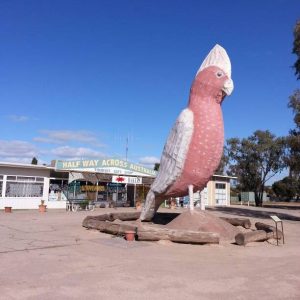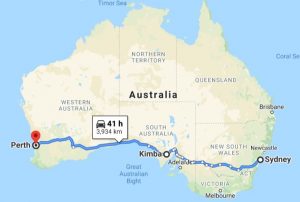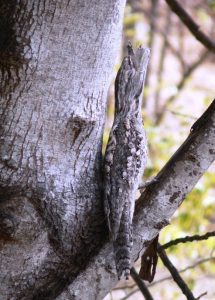Lyn’s birds’ words
This page features Lyn Richards’ poems about local birds. We asked Lyn to give us some background about how these poems came about. Here is her reply: “Birds’ Words was originally for my baby grandson (whose first word was ‘bird’) to show him the personalities of a dozen of his local birds and get him thinking about what they are saying.“
Australian magpies
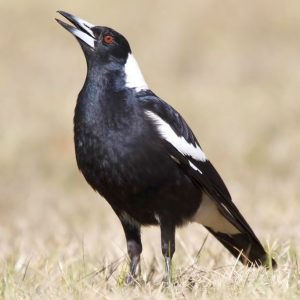 Music is the magpie in the morning,
Music is the magpie in the morning,
"Quardle oodle ardle wardle lay".
Welcome to the sunshine and a warning
To any worms not safely tucked away.
Sweetest is the magpie’s song at sundown
Chortling at the doings of the day.
Most birds by evening time have simply run down
But magpies warble on with lots to say.
Their song is long and liquid, and it reaches
Over trees and hills – to far away.
Most birds have words, but magpies sing in speeches,
"Quardle oodle ardle wardle lay".
[The Australian magpie has a wide variety of calls, many of which are complex and, unlike many other birds, the females sing as well as the males. And, of course, the Australian magpie is actually a type of butcherbird, not a type of magpie.]
Dawn chorus
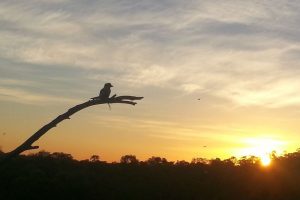 How strange that when we call at dawn
How strange that when we call at dawn
You should assume we greet the morn
In harmony, our carols bringing
Choral sound, communal singing.
The light is lovely, shadows shifting,
Treetop trills and pipes uplifting.
As the day unfolds before us
We greet the sun. But not in chorus!
Your choruses prepare, rehearse,
The lyrics scripted, neat, in verse.
Your music fitted to the words.
There's no libretto for us birds!
A human choir before it starts
To sing is organised in parts.
Each singer takes a part prepared
De-parting from it? That’s not dared.
Your choirs are dressed alike and neat,
Conductors rule, dictate each beat
Uniting voices in a splendid
Sound that’s woven, smoothly blended.
But why would birds unite in choirs?
Our music mingles our desires.
Each bird sings solo in the morning,
Some are flinging out a warning,
‘Boundaries!’ Some celebrate
A food source. Parent birds dictate
As restless nestlings agitate.
Some just sing to communicate.
And many market for a mate.
That dawn din sings in different words
From varied voices, worlds of birds.
[We tend to hear the bird calls in the morning as blended, romantically naming them a chorus. But, not only are they uncoordinated and unrehearsed, they are also very varied. Different birds start at different times and, in the breeding season (Spring), the chorus is loudest. Wikipedia reports a study of the Ecuadorian forest that showed that birds perching higher in the trees and birds with larger eyes started earliest, possibly because they saw more light. Not all birds sing at dawn, though nearly all songbirds will join in. The sounds are also not always melodious (video here from NSW).
Have you ever wondered why the celebrated ‘chorus’ is at dawn? Possible explanations include that, with low light levels, it's too early to start foraging, so the publicity work gets done then. There’s also less ambient noise stopping the birds getting out their messages and the lower temperatures send these messages further. And a bird displaying its vocal ability early implies that it is healthy enough to have got through the night!
Finally, some recent research has questioned the received wisdom that it's nearly always the males who do the singing and raised interest in the potential advantages of female-female communications. (Sounds like C20 sociology!)]
Eastern rosellas
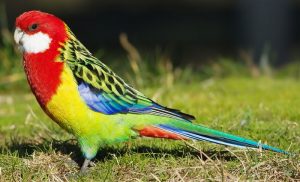 Our colours shine bright as we swoop
Our colours shine bright as we swoop
On your fruit trees, a chattering group.
We’re cheeky and bold
Red, blue, green and gold,
Much more than a logo for soup.
Given choice, yes perhaps we’d endorse
Some product with standards – enforce
That it had to be fruity
And known for its beauty,
This hardly applies to dead ‘orse.
 [The Eastern Rosella (Platycercus eximius) is one of our most multi-coloured parrots. The brilliant colouring is so complexly patterned that it blends whole flocks into foliage or grasses. But it’s their red heads, with white cheeks and beaks, that identify them.
[The Eastern Rosella (Platycercus eximius) is one of our most multi-coloured parrots. The brilliant colouring is so complexly patterned that it blends whole flocks into foliage or grasses. But it’s their red heads, with white cheeks and beaks, that identify them.
They feed in pairs (they mate for life) or family groups on the ground. They’re also unusually vocal – up to 25 different calls have been described for eastern rosellas. You know they are around by their un-parrotlike "pee-ping" contact call (almost like that of a bellbird) and their in-flight alarm call – a metallic "pink pink pink pink". Here is a video of their calls. They are seed eaters and ground feeders (until your fruit ripens!) But they are also keen on lerps, which are a major pest of eucalypts: watch this video.
Fun fact: the Rosella brand's 'iconic' logo was updated in 2016. "The reinvigoration of our logo communicates what Rosella has represented to Australian families for the last 120 years, but in a contemporary context," the company stated. The rosella has been "given flight" to represent the company "keeping pace with modern Australian eating" Did you notice?]
Eastern spinebills
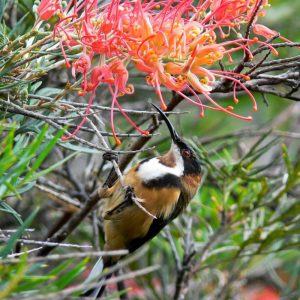 The cheekiest bird in our parts
The cheekiest bird in our parts
Is the spinebill, who dances and darts –
Quick, elegant, daring,
Slick acrobat, wearing
The smartest attire! Winning hearts.
Their tiny sweet pipe is so high
You'd think they were modest and shy.
But each cheekily sings,
"If you only had wings
Just think of the ways you could fly!"
They twitter while hanging from flowers
They tinkle in bushes for hours.
They hover for honey
And think you are funny
For having such limited powers.
They can dash, dangle, swivel and swerve
Flit and sip. Then they'll tweet and observe:
"If you were this light
You could feed here in flight –
If you grew a long beak with a curve."
[The spinebill is one of few Australian honeyeaters capable of hovering whilst feeding. But spinebills are not hummingbirds. Watch this video which explains the difference, celebrates the spinebill as our most skilful hovering honeyeater and discusses its cheeky 'tik' call. It also explains why this tiny bird, Lyn's favourite honeyeater, is rarely in our garden: spinebills feed alone or in pairs, and are easily driven out by flocking, larger honeyeaters like the bossy New Holland, which rules Lyn's garden. Hummingbirds have never reached Australia but ruby-throated hummingbirds were introduced in the mid-19th century, initially near Sydney then to Queensland and (unsuccessfully) to Tasmania. They’ve spread into SA and WA, but are reputedly not an ecological risk.]
Galahs
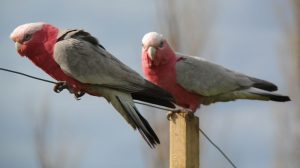 When someone says "You're a Galah!", do you think
When someone says "You're a Galah!", do you think
That they mean you’re so handsome in silver and pink?
Or that you and your friends can so brilliantly fly
In a cloud turning silver, then pink in the sky?
Or perhaps that your balancing act is so clever?
Do they mean you are smart? Or intelligent? NEVER!
It’s always "You SILLY Galah!" So who's silly?
You humans can't fluff feathers up when it's chilly.
You laugh at our noise when we chatter and squawk
But we're far more efficient than you when we talk.
One screech tells us "danger!" A squeal tells us "food!"
A long squawk means "Clear off!" (Galah words aren’t rude.)
And your sense of humour is really the joke
Would galahs waste their time building us a Big Bloke?
[The Big Galah, a member of Australian Big Things, is, at Kimba, at a point allegedly halfway across Australia. The 8 metre pink and grey bird is at 15351 Eyre Highway. Google Maps gives the distance from Perth to Sydney as 3,934km by road, the shortest road distance from Sydney to Kimba as ~1700km, and that from Kimba to Perth ~2230km, so it's not really close to halfway. As the 'crow flies' calculations also don’t make Kimba halfway. But maybe no other truck stop or 'big thing' is nearer halfway.]
 Grey butcherbirds
Grey butcherbirds
The butcherbird did not deserve
His ugly name, he feels.
What's wrong with his efficiency
In dealing with his meals?
His song's the brightest, sweet and loud
All spring and summer long.
He surely would be better named
The Bird of Lovely Song?
But being sweet of spirit,
He's happy to forgive
And so he sings with all his heart,
"A lovely place to live!"
[Whilst the grey butcherbird is common across Nillumbik, its song isn't! In Eltham, the local butcher birds, according to Lyn's Dad, sang “Twelve dollars twelve”! But when Lyn moved to Kangaroo Ground, she was wakened early and greeted all the day with a clear lilting musical call, "A lovely place to live"! Same bird, different postcode.
Grey butcherbirds often sing a favourite phrase involving two birds- male first, female responding. It's almost 'postcode specific' and a few kilometres away, you can hear another duetting pair with a different phrase altogether. Their song is a social song, usually a duet, sometimes with more group members. It's often antiphonal – i.e. different group members sing different phrases sequentially, or even overlapping, so you can't tell if more than one is singing. And it's territorial, announcing the territory with loud, clear, musical boundaries. Most songs are sung with more than one phrase, lasting up to 15 minutes.
This video shows how their duetting works.]
Grey shrike-thrushes
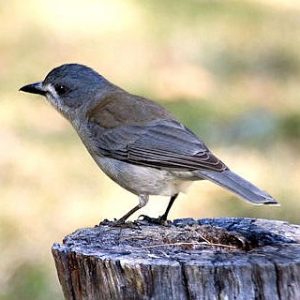 My song has no words.
My song has no words.
A spill of sweet sounds of morning,
Not a statement, or a summons, or a warning,
Like the calls of most birds.
You fit words to bird call.
Classify them. Check who’s singing,
Know your birds, hear a pattern, winging
Label. Mine defies recall.
Harmony swirls – words fail.
No shape, no repeating,
Notes drape above, fleeting,
Move like a shining veil.
So don’t seek a pattern.
When galaxies fire your dark night,
Proud planets shine with stunning light,
You don’t give words to Saturn.
I’m not talking to you.
To the trees and the light my liquid song calls
In a gentle cascade, each droplet note falls,
Feel it flow, cleanse, renew.
Song without words.
[Do you have gentle, liquid music in the morning and evening? And have you discovered the unobtrusive little grey-green bird that makes it?
Commonly described as ‘nondescript’ or even ‘drab’, the grey shrike-thrush spends most of its time in the tree canopy, but you may have seen it methodically picking insects off your window ledges.
It is one of the best songsters in Australia, with "hundreds, if not thousands, of different songs, most of which are musical masterpieces. The song has been described as glorious, pleasing and melodious, with sweet, mellow, rich and liquid notes." A male grey shrike-thrush may have a repertoire of up to 16 songs. Check out the range of calls in recordings here. And here is a video of a pair in the bush.
Fun fact – If you are blessed with these melody-makers, you will probably keep them: grey shrike-thrushes mate for life and hold territories of up to ten hectares, often nesting in the same site year after year. But it’s not such good news for other birds as it is yet another predator on eggs and nestlings.]
Photo: Geoff Walker.
King parrots
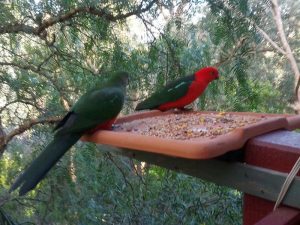 He's the King of Parrots
He's the King of Parrots
And she’s his Royal Queen.
His handsome head is brilliant red
And hers is gorgeous green.
But perched among the branches
They hardly can be seen.
They're the greatest parrots,
With strongest longest wing.
You’d think that they’d be loudest
But listen when they sing –
A little silver whistle,
A tiny bell-like ring.
Their talk is quiet and gentle.
This King and Queen don’t need
To squawk and screech to get their way –
They whisper as they feed.
"We’re glad you love it here, like us,
And thank you for the seed."
Laughing kookaburras
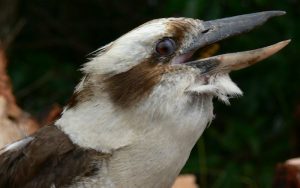 We think his call is laughing –
We think his call is laughing –
A funny noise to make.
But actually, he is calling
To say he’s wide awake.
He caught sight of his breakfast,
And now, make no mistake,
He’ll swoop and catch and carry it,
And laugh enough to make
You laugh out loud – but when you laugh –
He thinks you've seen a snake!
[Whilst male and female laughing kookaburras look similar, unusually they are 'reverse size dimorphic', which means that the adult females are typically larger than the adult males (by around 15%). They are also siblicidal, which means that the eggs in a clutch hatch at different times and, depending on the availability of food, the elder hatchlings might kill their younger siblings.
The laughing kookaburra is a species of kingfisher and its formal moniker is Dacelo novaeguineae. Here is the naming story, according to Wikipedia.
First, it's not native to New Guinea. Apparently its original describer, who never visited New Guinea, mixed up specimens.
Second, the genus 'Dacelo' is an anagram of 'Alcedo', which is one of the other genera of kingfishers. Some sort of in-joke?
The native peoples did better. The English name 'kookaburra' is a loan-word, derived from the Wiradjuri Aborigine word guuguubarra, which mimics the bird's laugh-like call. This is a good example of the richly onomatopoeic words in Aboriginal languages.]
Little ravens
[Not only does the poem below include hyperlinks, but it also has footnotes! Is this a world first?]
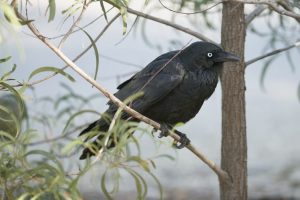 Let's start here – no
Let's start here – no
I'm not a crow!
I've nothing against clever cousin, the crow,
But you must be confused, he's not here. Did you know
All the world's corvids – crow, raven and jackdaw
Evolved from Australia? – (one returned by the back door).
Now they've sorted it – north of Newcastle are three crows1,
And south are three ravens – named…?
Nobody knows!
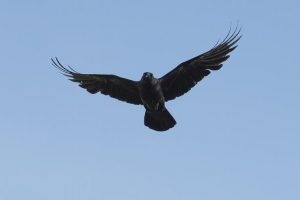 When humans take notice of birds that are locals,
When humans take notice of birds that are locals,
They go for bright plumage and sweet-tweeting vocals.
Just think how I feel when I hear you below,
"What's that bird on the gum tree?" "It's only a crow".
Once we were holy, the ancients admired
Our strength and intelligence, all that’s desired
In a bird! What went wrong with the corvid PR
Tells of human assumptions, frankly bizarre.
We eat carrion – so? Recycling is needed,
We’re all black? The beauty of black’s now conceded.
We gather in families – why call that a 'murder'?
Our noise? Conversation – just ask any birder.
I’m black and I’m glossy, I dive, swoop and soar,
I’m noisy and bossy, I "caaaar", "aaaaar" and "kaaaww".
I vocalise brilliantly, chat to my folks,
Solve problems, use tools, I play tricks and tell jokes.
(Hey, humans, how's this one? Take the 'aaaaar'; out of corvid2
And guess what you got? No – sorry, that's morbid.)
All of us corvids are glossy and black,
All of us corvids are smart as a tack,
(There are 120 species of corvids but those
Are clearly outshone by the ravens and crows.)
So when you find me in your Nillumbik haven
Please address me correctly, I'm a smart Little Raven3.
[1 Three ravens (Australian, Little and Forest) live in the temperate zone and sheep/wheat belt, and the two crows (Torresian and Little) inhabit the tropics and arid zone. The House Crow, the backdoor re-entrant from Asia, is a 'vagrant' with no territory. The differences are slight.
2 By which you would get covid.
3 Actually, I may be an Australian Raven, but that's less likely.]
Little wattlebirds
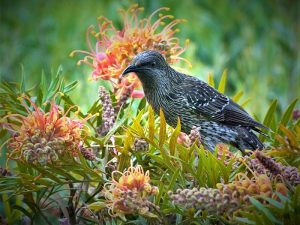 I'm certainly not little
I'm certainly not little
And I haven't got a wattle –
You mustn’t get me started on my name!
I'm in too much of a hurry
To agonise and worry
That my elegance and speed don’t bring me fame.
It's hard for any creatures
Named for someone else's features
To celebrate their true identity.
Red wattle birds are dominant
Their floppy wattles prominent
No wattle? I’m a bird nonentity.
Why would you want a wattle? They
Look silly and get in the way
When upside down exploring a grevillea.
My whopping wattled cousins break
The twigs with every flower they shake
And flopping, squawking off, look even sillier.
Our tweet is sweet, they shout and clack.
Our flight is neat, they crash and whack,
What shame for any proper honey-eater!
They’re bossy, dictatorial,
We’re far less territorial…
(Just stay away, at least a kilometre!)
[Wattlebirds (genus Anthochaera) are named from Greek: anthos meaning 'flower' and khairō meaning 'enjoy’. The common name is because the two largest wattlebirds have fleshy wattles, whose function is unclear, hanging from the neck or face.
The red wattlebird is our dominant, aggressive and noisy local, notorious for chasing smaller honeyeaters, but co-existing with the relatively quieter, smaller and swifter little wattlebird. Unlike most honeyeaters, the little wattlebirds are not migrants and their longest recorded travel is 10 km. Whilst they are indeed more tolerant of smaller birds than red wattlebirds, they are active guardians of territory. So when you have them, you’ll keep them, so long as your plantings are planned to provide flowers all year. And you’ll know they’re there, especially at sunrise. Note that the little wattlebird has many calls, not all sweet – listen here.]
The photo is courtesy of Marshall Richards.
Magpie-larks
[To a mudlark – with apologies to Shelley.]
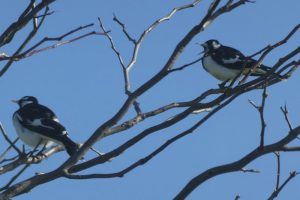 Hail me, handsome magpie-lark,
Hail me, handsome magpie-lark,
A very grounded bird,
I probe for insects, dawn to dark.
(In case you haven’t heard.
I’m not a lark or magpie – but my names are all absurd.)
Hail the murray magpie,
(My South Australian name)
I always wear a black tie
A white throat marks my dame.
We mate for life and sing duets, our greatest claim to fame.
Hail to me, sweet pee wee,
Prim in black and white,
My 'peep peep' rings out clearly
From grass or tree or flight.
I’m fussy, busy foraging, a little bit uptight.
Hail the mudlark, I'm the best
Bird-architect in dirt,
With mud and sticks I craft my nest.
Defend my chicks from hurt.
My call annoys? It warns: "This bird is always on alert."
(What did that poet mean by saying, ‘Bird thou never wert?)
[Is the magpie-lark (Grallina cyanoleuca), which is neither a magpie nor a lark, the only bird to have 4 different names specific to different Australian states?
Look at some photos with detail of markings, including the male/female differences in head colour pattern. Listen to the call. The magpie-lark is one of around 200 birds worldwide that sing 'duets' with their partner. They have two special duetting skills – they 'conduct' with body and wing movement and one partner will sing 'pseudo-duets' to divert a predator while the other guards the nest.
Lyn's normal morning foragers at Kangaroo Ground are groups of magpie-lark pairs plus Australian magpies (which, of course, are also not magpies!).]
Maned ducks (aka Australian wood ducks)
[with apologies to F.W. Harvey*]
 The troubles of your world?
The troubles of your world?
Don't dump on ducks.
We’re peaceable, sensible things
Pair for life, walk and fly
On strong legs and strong wings.
So long as there's water nearby
We deal with challenges any place brings,
Cross roads, stop trucks,
Forage wherever there's grass;
Sidewalk, golf course –
Dodge runners and balls
And the occasional horse.
The trouble is your world!
Don’t turn to ducks
For comfort, pretty pictures, silly rhymes.
Take action now –
We're all in dangerous times.
All ducks require is grass and trees, and yes,
Fresh water – best with muds and slimes.
What humans need – now here’s the crux –
Is what they wreck. So start reforming
Your politics and practice to address
Global warming.
*F.W. Harvey was a war poet, writing during the First World War of the troubles of the world and the beauties of Gloucestershire. His best known poem is 'Ducks', reputedly written on return from solitary confinement after an escape attempt, when he saw a fellow prisoner’s drawing of ducks.
[The maned duck (aka Australian wood duck) – Chenonetta jubata – is a regular springtime visitor to Nillumbik's grassy places. The plumage is complex and very different from other ducks, and the male's dark head has a neat mane. Pairs mate for life and nest in tree hollows, from which the new hatchlings are apparently tossed by the female from the tree to the ground, to gather in family groups and famously hold up traffic on roads.
Maned ducks are one of the few Australian native animals that has benefitted from European settlement – dams and grassy fields took them across all of Australia except the driest centre. But they are vulnerable to clearing of trees (and nest sites) as well as loss of water sources.]
The photo is by Rosie Nicola.
New Holland honeyeaters
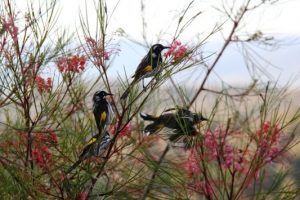 Zip, flip, loopy flight
Zip, flip, loopy flight
Swift shift, gold and white
Feathers fluffed in bright sunlight.
Eeep, cheep, teeny tweet
Carries forever, sharply sweet
Calls the crew to a meet and greet.
Neat feat, balancing trick
Hang from a petal, delicate, quick
Sip, slip then give it a flick.
Dash, crash, torpedo attack
Walloping wattlebird lands with a smack
Bombing the little birds, zooming back.
But a bush full of hidden birds chuckling and chittering
Secretly sniggering, bright feathers flittering,
Chatters in tweets, high fives sent by twittering.
Wattlebird glower on your treetop tower
Wait till a bird again rides every flower
Bomb! B52 with superb flying power…
But zip, flip, and the thickest twigs screen
Flashed feathers of yellow and white can’t be seen.
We ride in our hide of sharp, dense, prickly green.
Think of us, then, you people who push
Suburbia’s boundaries out to the bush
Clearing and battering, mowing land flat
Space for a playground, home for a cat.
Pruning sparse gardens, smoothing what’s rough –
That’s enough!
Please people, leave tough
Prickly stuff.
[The New Holland honeyeater (Phylidonyris novaehollandiae) was among the first birds from our continent to be scientifically described (hence the name). It is one of the most active – and aggressive – local birds. It is communal, performing ‘corroborees’, displaying and noisily chittering. To defend their territory, they use a ‘mobbing’ method: if an enemy or competitor nears, a watch-bird on a high branch warns sharply and a group forms fast to distract and attack. They often battle with wattlebirds over nectar bushes – whilst the wattlebirds are bigger, the New Holland honeyeater are usually in greater numbers. If you have New Hollands, there’s a price for this entertainment, however: more pacifist honeyeaters will go elsewhere.]
Noisy miners
(to be sung to 'O My Darling Clementine')
 In a garden, on a hillside,
In a garden, on a hillside,
Where the native plants entwine
Peace divine? … A noisy miner
Revs his raucous chorus line.
O my honour, O my image
We’ve become nefarious.
It’s forgotten, lost forever
That we’re fun, gregarious.
All our chatter doesn’t matter
Celebrates communal life,
And our scolding is resolving
Healthy internecine strife.
O my family, O my nestlings,
O my colony! It's cruel
You reject us – disrespect us!
Family First's our Golden Rule.
You may judge our noise excessive.
But it's surely not our fault
That the small birds, less aggressive
Beat retreat from our assault.
No! The blame belongs to humans
Forest clearing, urban habits
And that nasty ‘common myna’
Introduced (just like the rabbits).
But we're native, we're protected,
So although you castigate
Our behaviour, you've no option
Than to move to interstate.
[The noisy miner (Manorina melanocephala) is a gregarious and aggressive honeyeater, endemic to eastern and south eastern Australia, but not (yet) in WA and NT. It spreads with human habitat destruction, creating open woodland, and with urban planting of fast-food flora like grevilleas.
Despite the similar names, it is not closely related to the introduced common or Indian myna, which is a type of starling. However, the two birds do share some features, especially a striking yellow skin eye extension that gives a grumpy appearance. Their behaviour is also similar – strutting, bullying, chorusing and mobbing. Both are serious pests in the eastern states, driving out smaller native birds, but recent research, contrary to popular opinion, indicates that the native 'noisies' are the more threatening to diversity of local birdlife.
Noisy miners have a complex social structure, including communal feeding of the (very noisy) nestlings by up to 30 males. They defend their territory in ‘colonies’ of sometimes several hundred birds, made up of 'coteries' of birds owning a space, and forming 'coalitions' for tasks like bullying or mobbing a predator. But a note from Kangaroo Ground: the tough little new holland honeyeaters win (so far) over both noisy miners and Indian mynas!]
Pied currawongs
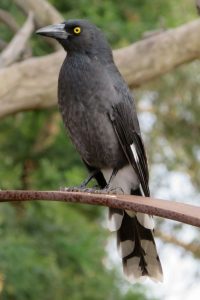 Swoop, looping flight,
Swoop, looping flight,
great wings strong;
Wolf-whistle, bright.
Others prolong
The call. Alight,
our tree top throng,
Chorus delight
in complex song.
Notes fall … good night.
Today was long
Sweet evening light.
Where we belong.
Currawong.
[The pied currawong (Strepera graculina) is one of three species of currawong, all native to Australia. They are named for the sound of their melodious song, probably adapting garrawaŋ from the local Jagera language in the Brisbane region. Watch this video.
Despite appearances, they are not directly related to crows, ravens or choughs but are, instead, in the same family as butcherbirds and the Australian magpie. They are tree dwellers, rather than ground foragers. If you are unsure about your identification, look for the golden eye!
The calls of pied currawongs can be heard throughout Eastern Australia, especially at dawn and evening. They are omnivorous, eating insects and larvae, fruit and, yes, the eggs and nestlings of other birds.
Fun fact: according to this research study, the tiny brown thornbill (Acanthiza pusilla) defends its young against pied currawongs by mimicking a chorus of other species' alarm calls that indicate a hawk (which is a predator of the currawong) is approaching.]
Rainbow lorikeets
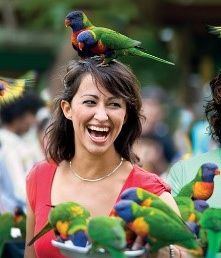 (To the tune of I am the very model of a modern major General.)
(To the tune of I am the very model of a modern major General.)
I am the perfect parrot for a photo opportunity
I perch on hats, or land on hands and poop there with impunity.
I squawk and talk or nip your ear and whisper you a pleasantry,
Bring tourists to the wildlife park and entertain the peasantry.
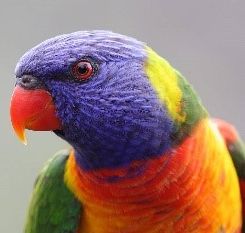 My plumage is superb, my colours absolutely exquisite –
My plumage is superb, my colours absolutely exquisite –
Blue, green, gold, red, for photos these are always a prerequisite.
All I need is lots of seed to profit your community!
I am the perfect parrot for a photo opportunity.
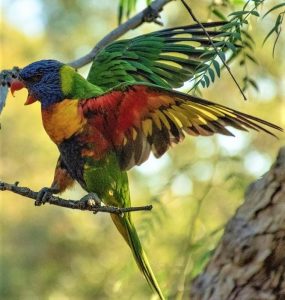 But look into my eyes, you’ll see another personality,
But look into my eyes, you’ll see another personality,
I'm mean and tough and smart enough for nasty criminality,
The bully at the seed tray, even when I've had sufficiency,
I’ll nick your lunch and eat it with remarkable efficiency.
I’ll call a mob to do a job, and we make no apology –
It’s all a part of (gee I'm smart) my lorikeet psychology.
Among the parrots it's well known I am an abnormality;
Just look into my eyes, to see my evil personality,
So when your apples ripen in this Eden that is Nillumbik
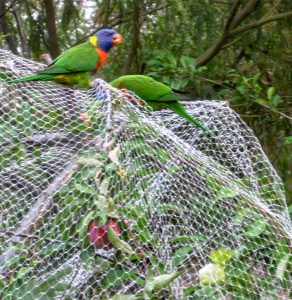 Your net, I bet, is useless to defend the crop you plan to pick.
Your net, I bet, is useless to defend the crop you plan to pick.
Like Eve I find an apple irresistible at any price.
A lorikeet sees nets as just a challenge – that's my best advice.
A tiny gap, a squeeze, a flap … it's apple cornucopia!
We peck each fruit to check it’s beaut, and croon about utopia.
We pick and nick, we're quiet and quick, displaying our agility.
Then you appear, you shout and swear and shatter the tranquillity.
Give up the fight, admit I'm right, I'm beautiful though Bolshevik!
Get your apples from the market and let friendship reign in Nillumbik.
[The third photo is courtesy of Marshall Richards.]
Red-rumped parrots
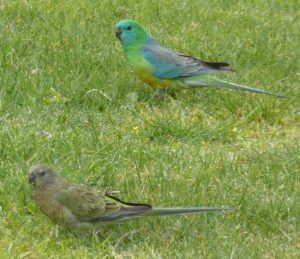 The parrots are the Opera of Birds' Arts
The parrots are the Opera of Birds' Arts
The costume, makeup, music and the voice
The divas and the chorus, winning all hearts,
As audiences cheer, applaud, rejoice!
Parrots are the Bollywood of Bird Shows
Colours that are brilliant, clashing, bold,
Trilling, thrilling highs and squawking bass lows
As scary plots of greed and lust unfold.
But look, the grasses move as sunlight's fading
Pairs of neat grass parrots quietly graze,
One subtly olive, green and yellow shading,
Her partner brighter blues, a small red blaze.
We're peaceful and communal, paired forever,
We come in flocks announced by choral tweet
We twitter as we work, we're quick and clever,
Our conversation’s gentle, quiet and sweet.
We're not the stuff of opera or drama
But all arts need the subtle with the grand.
We’re backdrop to Australia's panorama,
Background music for the soundtrack of the land.
[The common, undramatic little grass parrot is officially named the red-rumped parrot (Psephotus haematonotus) and is the sole member of a genus. It is camouflaged for pasture and easily overlooked but, once you notice them, grass parrots are a joy. Flocks can be over 30 birds here, over 100 birds in the outback, and their flocking flight is lovely to watch; when they settle on a tree, it’s always in pairs. Go to this site for images and here for more photos and video and audio.]
Spotted pardalotes
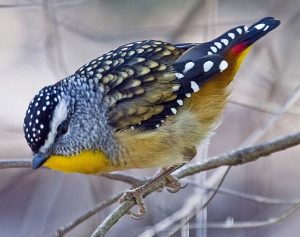 Of all local birds I’m the tiniest,
Of all local birds I’m the tiniest,
My feathers are neatest and shiniest.
My spots most delightful and daintiest
My colours are brightest and paintiest.
My flight is the fleetest and flittiest
No contest! I’m clearly the prettiest.
When I’m high in your trees, eating lerps,
From below you can’t hear my sweet chirps.
When I’m down digging nests in the ground
I’m secretive, making no sound.
But you’ll know if I want you to hear me
My call may perhaps not endear me.
Such a din from a creature so teeny!
Ostinato: ‘zucchini, zucchini!’
[The spotted pardalote (Pardalotus punctatus) is one of four pardalotes endemic to Australia and one of our smallest birds.
This video shows both their invisibility in the canopy and their nesting habits in the ground. Those holes and tunnels in your bank or soil heap may contain their nests – watch this video.
Listen to their little chirps and loud repetitive calls. From Wikipedia: an ostinato (from Italian: stubborn) is “a motif or phrase that persistently repeats in the same musical voice, frequently in the same pitch.” If Ravel’s Boléro distresses you, avoid spotted pardalotes! The repetitive bell-call is variously represented in mnemonics as ‘sleep baby’, ‘sleep-may-be’ and ‘kon tiki’. But being a gardener, I [Lyn] have always heard ‘zucchini’.
Here’s an interesting research story. The forty-spotted pardalote, limited to Tasmania, is endangered, and researchers from Australian National University set out to help preserve remaining colonies. Read about their answer or watch this video.]
Photo: Geoff Walker.
Sulphur-crested cockatoos
 The white cockatoos
The white cockatoos
wouldn’t know how to tweet.
Their screech fills the air
and it’s not very sweet.
They have just one message
to scream and repeat —
"What can we grab here
to pick, smash and EAT?"
Feast meet,
Quiet, neat,
Clever feet.
Meal complete –
Wings beat,
Screech – greet!
Superb blue wren
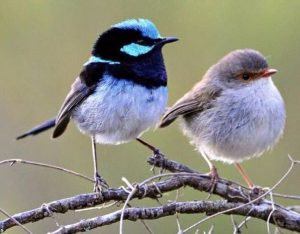 A chit and a ping to begin –
A chit and a ping to begin –
So tiny and high and so thin
You hardly can hear
When one fairy-wren’s here –
But when there’s a mob, what a din!
There’s never just one fairy-wren
A family of five, even ten,
Ping and pipe, their tails wiggling
In bird-talk they’re giggling!
Many helpers, a male and a hen.
“Do you know why we’re laughing at you?
Admit it, you haven’t a clue.
Well, you call us ‘blue wren’
But look closely again –
Have you noticed that only one’s blue!!?”
[Here is an article about why male superb fairy-wrens – the subject of Lyn’s poem – are blue. For many birds, including the superb fairy-wren, the males and females look very different. In such cases, it is nearly always the male that is colourful and the female that is dull. This happens because the females choose their male partners (the males are basically happy with any partner but the females are more choosy) and they happen to generally like colourful males. So, even though colour makes them more obvious to predators, the colourful males prosper and, over time, colourfulness has become prevalent. This is a process called sexual selection, which is a different process than natural selection even though both were discovered by Charles Darwin. Similarly, with some notable exceptions (such as Australian magpies), it is the male birds that sing rather than the females. And, of course, the archetypal example of sexual selection is the tail of the peacock.]
Tawny frogmouths
Bark speaks beauty,
Sheens of hard metals in live folds,
Feather-soft silver, copper, platinum.
Curving lines link, a crevice holds
Secrets. Ridges reach tall.
Leaves shade, veil, soften
Daylight to mystery. Shadows fall.
My words: "Ooom… Ooom."
[No it’s not a tree branch. The tawny frogmouth (Podargus strigoides), gentle and pacifist, relies on camouflage for survival. A single bird or pair (mated for life) hold still and silent for much of the day, posing to mirror the lines and shapes of bark. Then, ‘ooom … ooom’ – the low boom-mutter can go on all night. Here's a closeup of a tawny frogmouth calling. Other vocalisations are described here.
It’s also not an owl. Rather, frogmouths and owls are an example of convergent evolution, with both having similar large eyes and soft feathers. But, unlike owls, frogmouths don’t have either powerful wings or talons – as insect eaters, they don’t need them.
Names? Podargus is from the Greek word for gout – all frogmouths have little feet and walk awkwardly – though they’re nifty when pouncing on a bug. 'Frogmouth' refers to the beak opening, wide for catching insects, and bright yellow, for gaping display at predators. The Aboriginal name is, as always, more onomatopoeic: the Bundjalung word for the tawny frogmouth celebrates their night call – 'mumbir-mumbir'.
Fun fact: tawny frogmouths are the largest birds able to lower their own temperature to save energy. They can also regulate their body temperature to withstand heat as well as cold.]
Photo: Billabong Sanctuary.
Wedge-tailed eagles
(with apologies to Shelley)
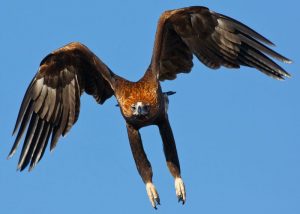 From high, the sovereign of our antique land
From high, the sovereign of our antique land
Descends. 'Desist from penning foolish rhyme!
'All doggerel on noble birds is banned,
'Lèse-majesté of eagles is a crime.'
I quail beneath his glare of cold command,
Duck as he soars above, the high clouds swallow
His power and beauty, lifted on widest wings.
(Indignant magpies can no longer follow.)
And yet I long to challenge, to protest,
'Poetry flies beyond a bird that sings!'
I seek an audience at his monstrous nest
To claim my right to versify an eagle.
A covenant achieved: at his behest
A sonnet is allowed – if duly regal.
[The wedge-tailed eagle (Aquila audax) has the greatest wingspan (over 2½ metres) of any eagle in the world. But for an eagle, it’s unusually light, allowing it to spiral easily up in thermals. Watch this video of their flight.
Their glaring eyes are the size of human eyes, but wedge-tails can see much better, and with a wider range of colours, than humans, and they can squeeze and elongate their eyeball to gain a zoom view from a great height.
This is not a bird that sings – the call is a harsh 'pee-yaa'. They are monogamous and mate for life. They are territorial and aggressively defend their massive (2 metre diameter) nests from other birds – and drones! Watch this video over the Yarra.]
The photo is by Fir0002/Flagstaffotos, courtesy of Wikimedia Commons.
Welcome swallows
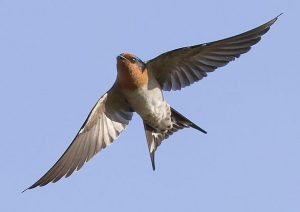 Suddenly the sky’s alive with swallows,
Suddenly the sky’s alive with swallows,
Swooping, looping, aerial ballet,
Welcome sight for sailors seeking landfall,
Welcome sign that spring is on the way.
It seems I’m not so welcome in your garage
Swooping, looping (pooping!) round my nest
Irregular arrivals are disruptive –
No migrant is presumed a welcome guest.
We came on tiny wings across the desert,
Our needs are few, we thank you with this dance.
We’ll disappear as suddenly in autumn –
But entertain you while we have the chance.
[The welcome swallow (Hirundo neoxena) is a tiny (10 grams fully grown) Australian migratory native, with those in eastern Australia going north for winter and coming south in spring. They work collaboratively to build mud and grass nests high in eaves and pipes, and they fly in flocks (photos here). To drink on the wing, they fly low over water. They feed on insects, caught in their swift agile dance, set to a sweet, twittering song (video here). They eat around 400 times a day, taking in their own body weight.
Fun fact: welcome swallows have 'rictal bristles' around the bill, usually explained as a way of guiding insects into the open mouth and protecting the eye during the rapid flight. Some recent papers challenge this account for lack of evidence, suggesting the bristles may have a sensory function or are simply tougher-than-normal feathers to protect the bird during fast flight.]
White-winged choughs
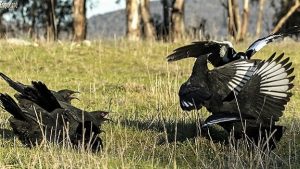 I'm a white winged black beauty, the chough
I'm a white winged black beauty, the chough
Say it wrong, and I’ll get in a hough.
Through your garden we scoughle
And make a kerfoughle
To show that our mob's really tuff.
We've some secrets you might find unsavoury.
We're the only birds practising slavery!
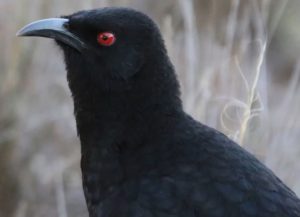 We make nests out of mud.
We make nests out of mud.
Our red eyes bulge with blud
When we need to impress with our bravery.
But a mob is not always nefarious.
We're social, communal, gregarious.
Our play's never ruff.
When we screech, hough and pough
As we shoughle around, we're hilarious.
[The white-winged chough (Corcorax melanorhamphos) is a mud-nest builder. They flock in family groups of up to 20 and are 'obligate cooperative breeders', which means that they must breed in groups in order to produce offspring successfully. Their mud nest may contain eggs from several birds. You will know if they are in your garden, foraging in the leaf litter and muttering to each other (watch this video). They are strong walkers and poor flyers, making a big fuss if disturbed (watch this video). Check out this blog for some images of the chough's red eyes.
The white-winged chough is allegedly the only bird that practices slavery, taking young fledglings from another mob to help with their generally inefficient raising of chicks. (But this accusation, from Wikipedia, which quoted David Attenborough, seems to Lyn to possibly be an anthropomorphism – perhaps the chicks just wanted to move mobs.)]
White-faced herons
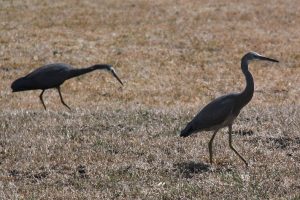 The heron is a silent bird
The heron is a silent bird
Not one to sing or squawk.
He sometimes gives a funny croak
And then goes back to stalk.
He's busy being beautiful,
He hasn't time to talk.
If you were half as proud as he
You’d simply pose and walk.
Some birds
Need no words.
[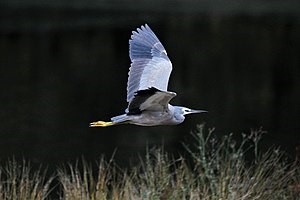 The white-faced heron (Egretta novaehollandiae) is said by some to symbolise peace, calm, intelligence, patience and tranquillity. It presumably won that reputation by being an often solitary feeder and stalking prey silently, waiting, still, to skewer creatures from the water it likes to be near – or, as in this picture, from the deep cracks in the dry summer black clay of Kangaroo Ground. White-faced herons live pretty much everywhere in Australia, except the driest centre of the continent – they don’t need wetlands.
The white-faced heron (Egretta novaehollandiae) is said by some to symbolise peace, calm, intelligence, patience and tranquillity. It presumably won that reputation by being an often solitary feeder and stalking prey silently, waiting, still, to skewer creatures from the water it likes to be near – or, as in this picture, from the deep cracks in the dry summer black clay of Kangaroo Ground. White-faced herons live pretty much everywhere in Australia, except the driest centre of the continent – they don’t need wetlands.
They make a funny croak, usually when flying – you can hear it here.
How do you know if a large waterbird overhead is a heron? All species of herons fly with the neck retracted, not stretched out.]
Willie wagtails
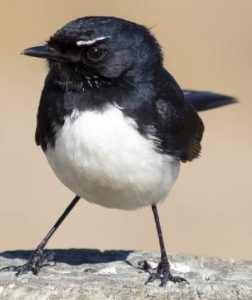 I'm a smart, savvy wagtail called Jillie
I'm a smart, savvy wagtail called Jillie
Who thinks human habits are sillie!
You assume we're all male
And defined by wagged tail!
I’m a fantail whose name isn't Willie.
Tail-waggings a trivial feature;
While I trill, singing 'sweet pretty creature',
(in your bird-song mnemonics),
I can scream histrionics –
Come close to my nest and I'll teach ya!
I say this without an apology:
You need to improve ornithology
Names must fit either gender
You'll always offend her
Till you ditch that passé ideology.
[The photo is from the Courier Mail.
The willie wagtail (Rhipidura leucophrys) is Australia’s largest fantail. It has two main calls – a 'sweet pretty creature' call and a loud 'rat-a-tat-tat' of aggression and defence – listen to both calls. It can harass, and even attack, far bigger birds, including wedge-tailed eagles, kookaburras and ravens. It drives its own chicks out of its territory soon after they leave the nest: view the nest drama. Watch out for a wagtail's formidable eyebrow – it expands with aggression!
Its Noongar name, Djiti Djiti, comes from its call and Aboriginal lore treats the willie wagtail with caution – it's considered a stealer of secrets and bringer of bad news, which lures children away with its cheeky acrobatic familiarity.]
Yellow-tailed black cockatoos
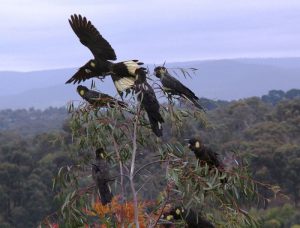 The great, long call is hills away –
The great, long call is hills away –
Fills the air “Kee-ow, why-AAYY”
Then coming closer – now beware,
Great black wings slowly beat the air!
They glide down, swooping in to land.
Not scary if you understand
Their quiet chuckle, happy band,
They’re saying, “Guess who owns this land?“

